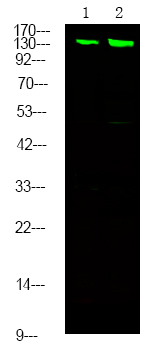
| WB | 咨询技术 | Human,Mouse,Rat |
| IF | 咨询技术 | Human,Mouse,Rat |
| IHC | 咨询技术 | Human,Mouse,Rat |
| ICC | 技术咨询 | Human,Mouse,Rat |
| FCM | 咨询技术 | Human,Mouse,Rat |
| Elisa | 咨询技术 | Human,Mouse,Rat |
| Aliases | PPP1R12A, M130, MYPT1, MBS, Myosin binding subunit |
| Entrez GeneID | 4659; |
| WB Predicted band size | 115kDa |
| Host/Isotype | Rabbit IgG |
| Antibody Type | Primary antibody |
| Storage | Store at 4°C short term. Aliquot and store at -20°C long term. Avoid freeze/thaw cycles. |
| Species Reactivity | Human,Mouse,Rat |
| Immunogen | A synthesized peptide derived from human MYPT1/2 (Phospho-Ser668/Ser618) |
| Formulation | Purified antibody in PBS with 0.05% sodium azide. |
+ +
以下是关于MYPT1/2 (Phospho-Ser668/Ser618)抗体的3篇参考文献,涵盖其在功能研究中的应用:
1. **"Regulation of myosin phosphatase by Rho and Rho-associated kinase (Rho-kinase)"**
- **作者**: Kimura K, et al.
- **摘要**: 该研究通过使用Phospho-Ser668抗体,揭示了RhoA/ROCK信号通路通过磷酸化MYPT1的Ser668位点抑制肌球蛋白磷酸酶活性,从而调控平滑肌收缩。
2. **"Phosphorylation of the myosin phosphatase targeting subunit regulates vascular smooth muscle cell cytoskeletal organization"**
- **作者**: Velasco G, et al.
- **摘要**: 利用Phospho-Ser618抗体,研究发现MYPT2的Ser618磷酸化在血管平滑肌细胞骨架重组中起关键作用,影响细胞迁移和收缩功能。
3. **"Distinct roles of MYPT1 phosphorylation sites in cellular contractility and migration"**
- **作者**: Grassie ME, et al.
- **摘要**: 通过对比Phospho-Ser668和Ser618抗体的检测结果,揭示了MYPT1不同磷酸化位点对细胞收缩和迁移的差异性调控机制。
这些文献均通过特异性抗体验证了MYPT1/2磷酸化位点的功能,为相关信号通路研究提供了关键实验支持。
The MYPT1/2 (Phospho-Ser668/Ser618) antibody detects phosphorylated forms of the myosin phosphatase targeting subunits 1 and 2 (MYPT1 and MYPT2), key regulatory components of the myosin light chain phosphatase (MLCP) complex. MYPT1 and MYPT2 are critical for modulating smooth muscle contraction and cytoskeletal dynamics by dephosphorylating myosin regulatory light chains (MLC20). Phosphorylation at Ser668 in MYPT1 (or the analogous Ser618 in MYPT2) is a regulatory event that inhibits MLCP activity, promoting sustained MLC20 phosphorylation and enhanced contractile force. This phosphorylation is mediated by kinases such as Rho-associated kinase (ROCK) and citron kinase, which are activated downstream of RhoA signaling pathways.
The antibody is widely used to study pathways regulating smooth muscle function, vascular tone, and cellular motility in contexts like hypertension, cancer metastasis, or neurological disorders. It enables researchers to assess the activation status of RhoA/ROCK signaling, a pathway implicated in diverse physiological and pathological processes. Detection methods include Western blotting, immunohistochemistry, and immunofluorescence, often applied in cell culture models, tissue samples, or disease-specific animal models. By targeting these phosphorylation sites, the antibody provides insights into how dysregulated MLCP activity contributes to conditions involving abnormal contractility or cell migration, making it a valuable tool for both basic research and therapeutic target validation.
×